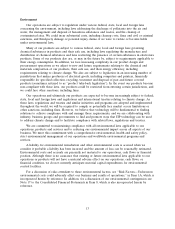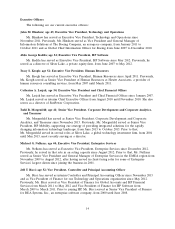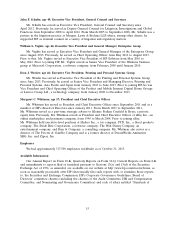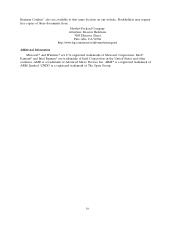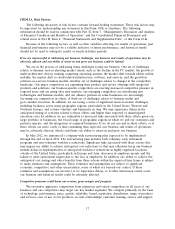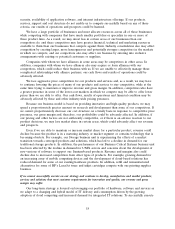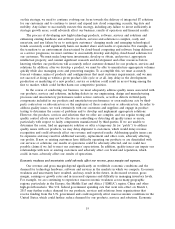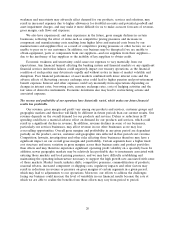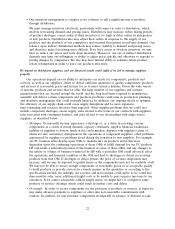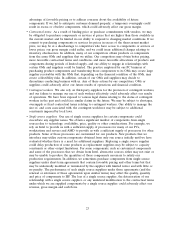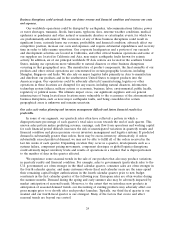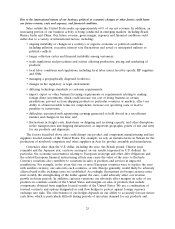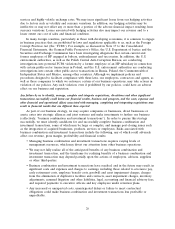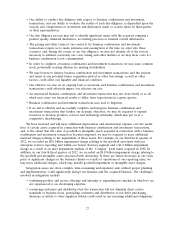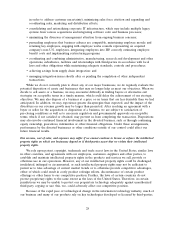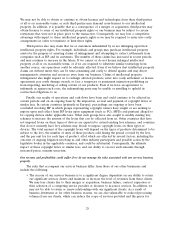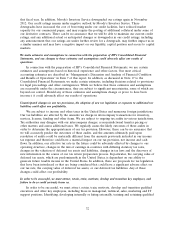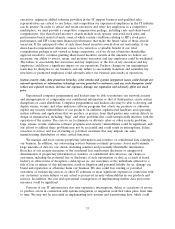HP 2013 Annual Report Download - page 31
Download and view the complete annual report
Please find page 31 of the 2013 HP annual report below. You can navigate through the pages in the report by either clicking on the pages listed below, or by using the keyword search tool below to find specific information within the annual report.advantage of favorable pricing or to address concerns about the availability of future
components. If we fail to anticipate customer demand properly, a temporary oversupply could
result in excess or obsolete components, which could adversely affect our gross margin.
•Contractual terms. As a result of binding price or purchase commitments with vendors, we may
be obligated to purchase components or services at prices that are higher than those available in
the current market and be limited in our ability to respond to changing market conditions. If we
commit to purchasing components or services for prices in excess of the then-current market
price, we may be at a disadvantage to competitors who have access to components or services at
lower prices, our gross margin could suffer, and we could incur additional charges relating to
inventory obsolescence. In addition, many of our competitors obtain products or components
from the same OMs and suppliers that we utilize. Our competitors may obtain better pricing,
more favorable contractual terms and conditions, and more favorable allocations of products and
components during periods of limited supply, and our ability to engage in relationships with
certain OMs and suppliers could be limited. The practice employed by our PC business of
purchasing product components and transferring those components to its OMs may create large
supplier receivables with the OMs that, depending on the financial condition of the OMs, may
create collectibility risks. In addition, certain of our OMs and suppliers may decide to
discontinue conducting business with us. Any of these actions by our competitors, OMs or
suppliers could adversely affect our future results of operations and financial condition.
•Contingent workers. We also rely on third-party suppliers for the provision of contingent workers,
and our failure to manage our use of such workers effectively could adversely affect our results
of operations. We have been exposed to various legal claims relating to the status of contingent
workers in the past and could face similar claims in the future. We may be subject to shortages,
oversupply or fixed contractual terms relating to contingent workers. Our ability to manage the
size of, and costs associated with, the contingent workforce may be subject to additional
constraints imposed by local laws.
•Single source suppliers. Our use of single source suppliers for certain components could
exacerbate any supplier issues. We obtain a significant number of components from single
sources due to technology, availability, price, quality or other considerations. For example, we
rely on Intel to provide us with a sufficient supply of processors for many of our PCs,
workstations and servers and AMD to provide us with a sufficient supply of processors for other
products. Some of those processors are customized for our products. New products that we
introduce may utilize custom components obtained from only one source initially until we have
evaluated whether there is a need for additional suppliers. Replacing a single source supplier
could delay production of some products as replacement suppliers may be subject to capacity
constraints or other output limitations. For some components, such as customized components
and some of the processors that we obtain from Intel, alternative sources either may not exist or
may be unable to produce the quantities of those components necessary to satisfy our
production requirements. In addition, we sometimes purchase components from single source
suppliers under short-term agreements that contain favorable pricing and other terms but that
may be unilaterally modified or terminated by the supplier with limited notice and with little or
no penalty. The performance of such single source suppliers under those agreements (and the
renewal or extension of those agreements upon similar terms) may affect the quality, quantity
and price of components to HP. The loss of a single source supplier, the deterioration of our
relationship with a single source supplier, or any unilateral modification to the contractual terms
under which we are supplied components by a single source supplier could adversely affect our
revenue, gross margin and cash flows.
23


